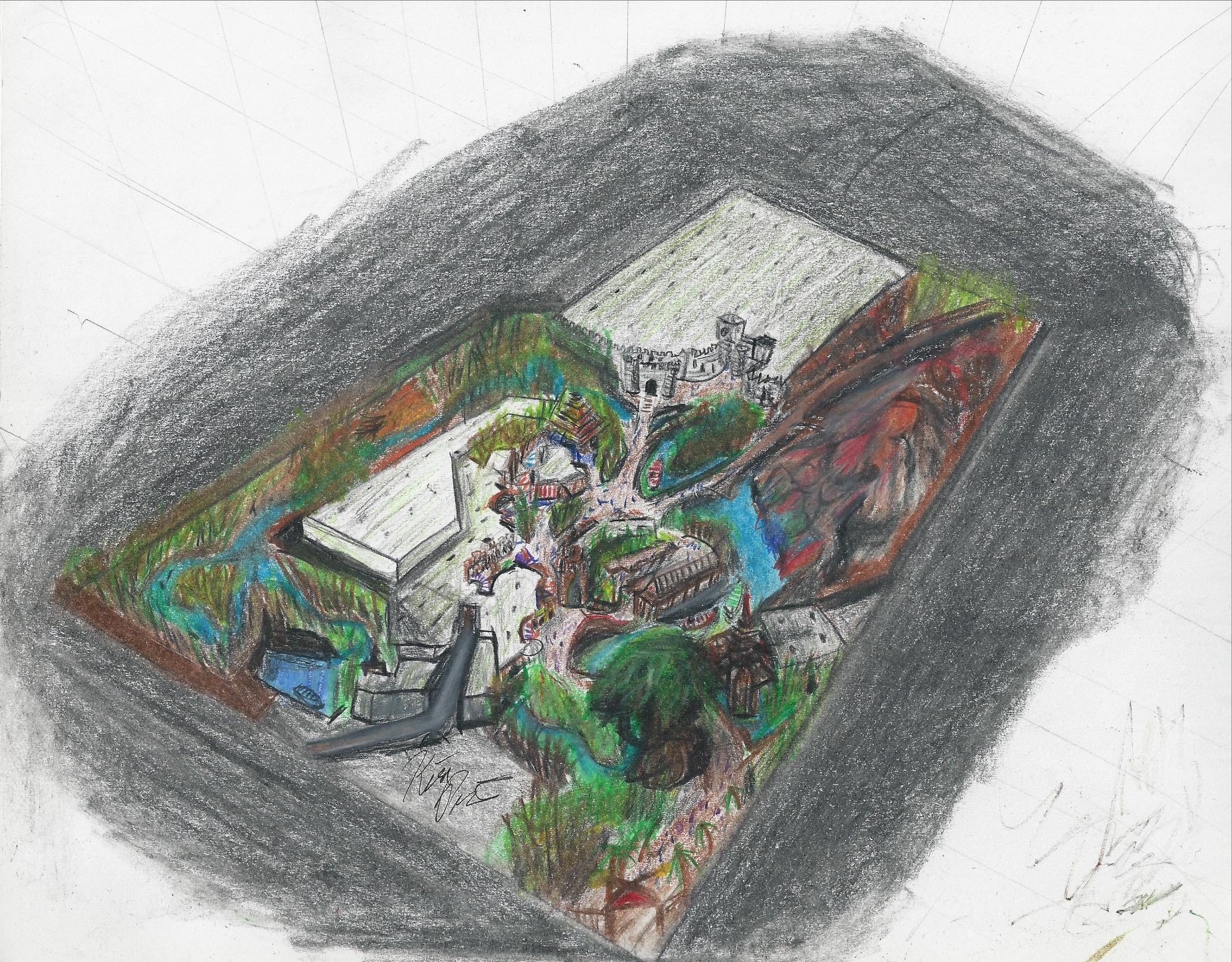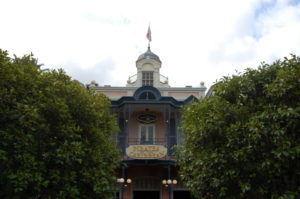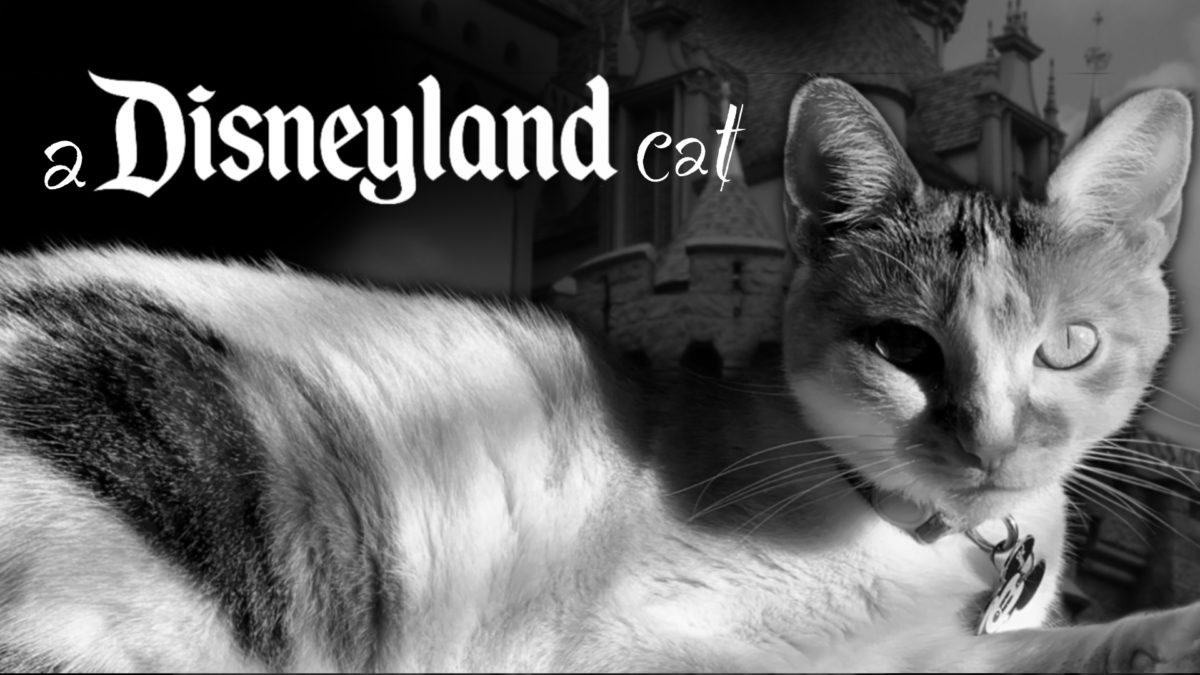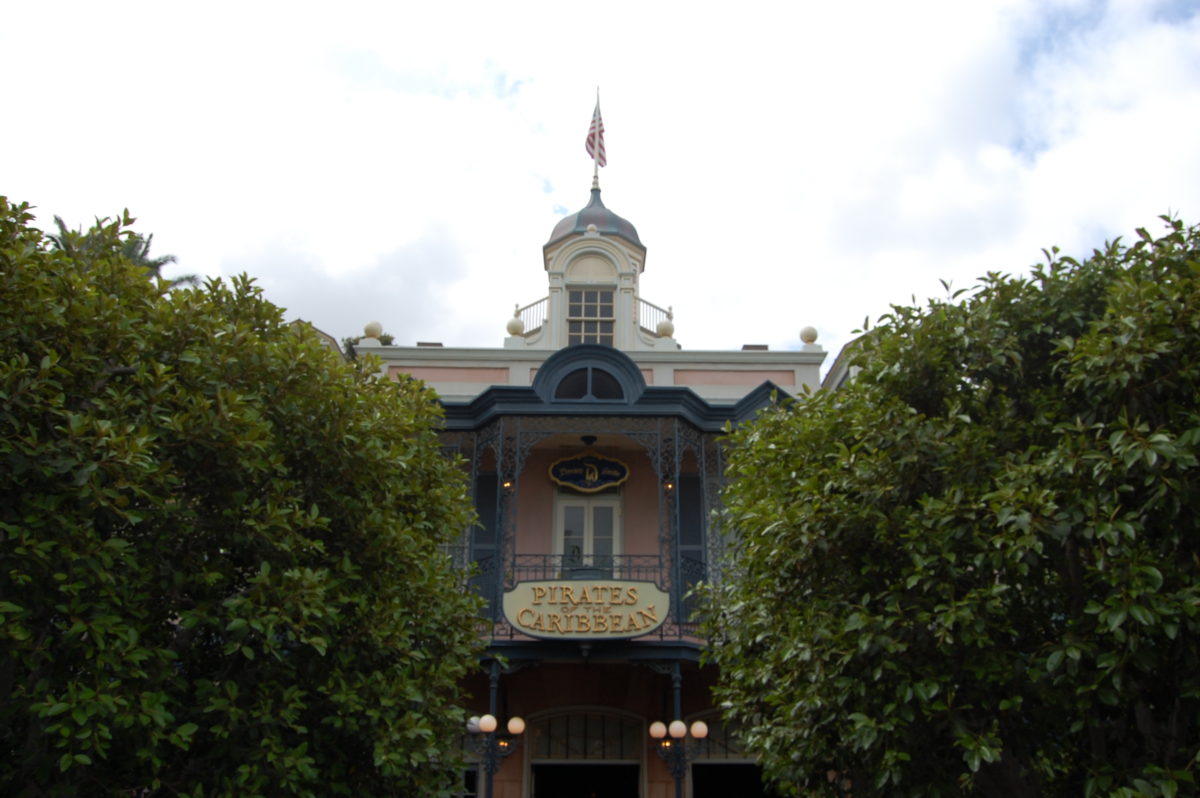It’s what you’ve all been waiting for I know, the sheet music to the legendary, chart-topping, 116 listen, I want to be a Disneyland Cat is now available for download for FREE! Now you can perform this ditty with your itty bitty kitty whenever and wherever you’d like! Have a great April!
A-Disneyland-Cat-Sheet-MusicTag: Disneyland
Theme Park Musing #8 – Disneyland’s Theme
People tend to analyze Disneyland as a thematic treatment of America and American mythology – which is definitely an accurate reading – and the optimistic point of view is often characterized more as like a tone or even a flaw. But sitting here this morning listening to Put on your Sunday clothes (a song that plays on Main Street and about relentless aspiration) it’s occurring to me that perhaps even more than American mythology optimism itself IS the theme of Disneyland. It runs through every land and every attraction and is reflected back at us through various lenses (namely American, white, upper middle class lenses). In fact I think the general critique so often heard might be exactly backward: that the theme of Disneyland isn’t about America with an overly optimistic lens it’s about optimism with an overly American lens. And that its flaws (if they are to be considered flaws) come from that.
Each land in the park reflects a distinct period of either history or culture where optimism and hope for a better tomorrow are at its zenith, at least from that lens. That IS the common thread. We enter Main Street USA right at the turn of the century – a period before the depression and before the World Wars where the marvels of technology are making life better on what seems a daily basis. Where steam trains carry us off onto exciting destinies, where everything is colorful and rosy, architecture is over the top, and people wear their Sunday best every day. People in this sleepy town coming into its own dream of the people they’ll be one day, the things they will achieve, the wondrous things that await them, and whadaya know at the far end of the street a shimmering castle beckons them forward towards their dreams – a symbol of things to come.
At the hub a series of adventures await us – each a microcosm of the same story. In Adventureland a “untamed” jungle is awaiting man to conquer it, unveil it’s riches and/or unveil itself as the tropical paradise it was always meant to be. A similar story awaits in Frontierland where the promise of manifest destiny is new, gold awaits, and the horizon is limitless. In New Orleans Square it’s a party all the time and a reflection of the promise of the west, both a realization and one of the last stepping off points before the frontier. In Walt Disney World this theme is even better reflected as Liberty Square and revolutionary America is swapped in – another era in which fears and darkness are cast off in favor of a new vision of what a better tomorrow could look like. On the other side of the hub, a literal vision of tomorrow, Tomorrowland reflects what Main Street might look like in hundreds of years: technology has fulfilled it’s promise, no one wants for anything, the world and universe are at peace, convenience and leisure are everywhere, and all sorts of transportation are waiting to whisk you off to literally anywhere you please. And finally Fantasyland, usually the hardest land to fit into the “americana” interpretation, fits perhaps most with the optimistic and hopeful theme and is fittingly at the heart of the park. Here we see a land inhabited by characters with often terrible pasts, overcome them and achieve their dreams. Snow White and Dumbo overcome abuse and trauma. Peter Pan teaches children to fly, an archetypal metaphor, and hold onto their childhood. Mr. Toad has crazy fun with friends, Pinocchio and Geppetto get their wish and overcome heartache and fear and loneliness. Alice escapes the doldrums of victorian life, etc, etc. And off in the back corner of the park, which I’m sure if it had been designed from day one, would have laid straight back from the castle: the end of the yellow brick road as it were, lies a monument towards optimism, cooperation, and a better tomorrow again in the form of “it’s a small world.” It’s telling us that to achieve the dreams of the future it will take all of us uniting together.
Disneyland and the Magic Kingdom therefore are really embodiments of the Disney ethos of their time: a strong conviction that the world is an exciting amazing place and no matter how bad things might have been or look to you now, a great big beautiful tomorrow lies just a dream away. And notably, that it’s up to us as a whole to take us there. The lands not only celebrate optimism but human achievements in realizing that optimism – whether it’s man conquering the jungle or frontier, the creation of a modern democracy, or characters escaping their haunting pasts. The park even tells us that death isn’t to be feared but enjoyed! (The haunted mansion). Perhaps it’s no surprise that these parks are more popular than ever before, given the world we find ourselves living in at the moment.
The flaws in the park’s treatment then, aren’t the optimism itself, but rather the somewhat outdated, very white, very American, very classed stories it chooses to tell – particularly on the western side of the park (and perhaps with its historic coziness with monopolistic corporations as well) that were only optimistic and pleasant for the people who wrote the history. For the time they might have been appropriate given the audience they were designed for, but today some of the implications can make you a bit uneasy. I’d still hold that the bones are good, that those settings can still reflect themes of optimism while becoming more aware and inclusive, and indeed over time we’ve seen very slow changes to that effect. For example, Thunder Mountain – while initially perhaps a glorification of gold mining has over time with various story changes become more and more of a morality play about what happens to those who are reckless in their pursuit of profit – something a certain company might take a lesson from. I for one, as perhaps one of the more obvious examples, would love to see what a Disneyland would look like with stories of the immigrant experience of the same time period paralleling those on Main Street. At any rate, like America, Disneyland is flawed, but it’s themes are solid. Optimism, hope for the future, and the responsibility to foster that future, are the themes that lie at the heart of the stories it tells and why people keep coming back.
P.S. This again reinforces the idea that I think Joe Rohde first articulated: that theme parks NEED themes in the literary sense to achieve their full potential and be effective: that that is what separates the good from the bad park executions, and Disneyland in particularly is a great example of what occurs when nearly every element of the experience serves to reinforce and drive home a particular message.
Theme Park Musing #6 – IP
The problem when you only want to use IP, is that you really start to narrow the scope of your offerings and everything starts becoming a bit homogenized. How many nighttime spectaculars can you have that feature the same dozen or two films? The same ones that all the rides you went on were based on, and the shows, and the food, and shops, and merchandise, and supplementary experiences, etc.
Don’t get me wrong I think the use of IP can be great, and Disney – for example – certainly has a lot of good ones. But still a family visiting the resort for the week in the world of a nonstop barrage of princesses and Pixar is going to be overloaded. And the target audience becomes smaller as well – only people who want to be overloaded with Mickey and friends. The beauty of WDW as it was for a long time, and still a bit to this day is the breadth of what is offered. Each park gives a different experience, a different tone, etc. Unique one of a kind of experiences like Hoop Dee Doo, La Nouba, the Safari, World Showcase, etc all are products worthy of a Disney name – but they’re Disney because they’re family oriented and they’re quality, not because they fit in with a tightly vertically integrated set of brands.
And this IP issue applies to all parks, not just Disney. Why limit yourself to a narrow catalog of flavors that have been hashed and rehashed and arguably no one wants in the first place? You risk turning your parks from interesting one of a kind experiences into just another manifestation of the toy section at Walmart.
It’s really a push to commoditize – to turn everything into a franchise; and frankly theme parks have historically served to get us away from the mass francisization of the rest of our world – places full of unique individuality. Instead, today they’re becoming prime examples of that process – shopping malls mercilessly cut into distinct marketing verticals.
There’s room for some of this to happen, room for a lot of it to happen without ruining what is there – but that room isn’t endless and the trends are worrying. Theme parks, like any form of art, need to be able to stand on their own, not just be an elaborate merchandising and advertising branch of their parent company. People can sense that and sure they’ll visit because they’re interested- but people visit World of Coke or the Hershey Factory once or twice. They don’t form emotional bonds with them – and if you want your guests to keep coming back – like the current crop of guests you’re relying on – you need to create those emotional bonds which means you need to create something that actually says and means something and isn’t hollow. That’s why the current crop of guests is so loyal – because of the decades of attachment and experiences that have preceded.
And furthermore for theme parks to be successful,memorable, impactful – they need to be cohesive, they need to have a point of view, they need to have themes in the narrative sense – not in the Birthday party sense. Otherwise they’re forgettable and trivial. This is obvious to anyone who has been to a castle park, Animal Kingdom, old Epcot, Disney Sea, and even Islands Of Adventure to a degree. And yet it’s continually ignored by people in charge.
Anyway this rant has gone on long enough – and I am optimistic, the people at the top might not have their priorities in great places but the people in creative positions do. The people that work at Pixar and Disney animation have worked out a nice balance of being able to tell great meaningful stories while still balancing the needs of the corporate overlords and that leaves me hopeful that the same can happen in the theme park world as well. And I’ll be the first to admit there’s a lot of underutilized IP that should have been turned into attractions ages ago – what we see these days is in no small part a reaction to that. And maybe one day, almost certainly one day, new unique experiences will again be a priority – breadth, variety, and novelty will be the new vertical integration as business strategies constantly shift. But at any rate it’s still frustrating, and worrying, and we’ll just have to see what happens.
Oh There’s A Great Big Beautiful Assortment (of Reasons People Visit Everyday)
Recently, I was watching an episode of Super Carlin Brothers, a Youtube channel devoted to Disney, Harry Potter, fan-theories, and other miscellaneous pop-culture nerdom and was excited to see a video about their recent trip to Walt Disney World. Alas, the excitement quickly turned to dismay as criticism was turned to none other than Figment from Journey into Imagination. Who was this character, they asked, how dare he have a ride devoted to him when he doesn’t even have a movie or tv show? I felt a knife twist into my heart. No! How can you not understand the brilliance of having an attraction not based on pre-existing IP? Do you not understand the history of this character?
But wait, that’s not all. It wasn’t long after that I, in what seems to be a monthly occurrence, was watching or reading some top ten list on a theme park blog and wincing as bare steel roller coasters or incoherent monstrosities appeared higher on the lists than classics like Thunder Mountain, Pirates, or new ground-breaking attractions such as Flight of Passage. What!?! How can you even think of comparing Millennium Force with Space Mountain?
But it gets even worse. Routinely I’m dragged into debates on internet forums and blogs about how Harry Potter and the Forbidden Journey is more groundbreaking than this or that because robot arms > everything, or how Evermore and Star Wars land are going to change the industry because they’re going to bring live action role-playing games to the industry and how immersive that is. Think of the stories. It goes on and on and on a spinning whirlwind as I scream into the abyss, “BUT WAIT THAT’S WHAT NOT THEME PARKS ARE FOOOOOOOOOOOOOOOOOOOOOOOOOOOOOOOOOOOOOOOOOOOOR!!!!”
For me.
Perhaps it’s time to take a breath. Continue reading “Oh There’s A Great Big Beautiful Assortment (of Reasons People Visit Everyday)”
Only You Guys are Going on This Special Mission
It seems there was a time during the 90s and 00s when no ride could open without us, the guest, being thrust on some mission we didn’t know we were there for. On Dinosaur we were co-opted into rescuing some rosetta stone of a reptile, on Spider-Man thrust into reporting on a man with a levitation-fetish, unwilling science experiments on the Hulk, Alien Rescuers in ET, substituting for crash test dummies on Test Track. Or else we were tourists. Touring an old hotel, touring the galaxy, touring a movie studio, touring some institute, touring an ancient temple – no not of the Forbidden Eye, of Poseidon, touring touring touring. (For a list of exhaustive tropes, including these check out Passport to Dreams). The goal here is admirable. The landscape of themed entertainment was changing bringing with it a new breed of attraction where the audience isn’t just an audience anymore but an active participant in the story.
However there’s a problem with this and it centers around the concept of cognitive dissonance: when your mind has to hold two contradicting ideas as both true. When an experience asks you to role play, it asks you to put aside your own internal thoughts, feelings, and motivations, and substitute them with what it provides. Generally this doesn’t work out very well in any medium, but it’s particularly difficult in themed entertainment because your own internal thoughts, feelings, and experience are so central to the entire endeavor. Designers often made the mistake of telling stories about us instead of about the worlds we were in. And stories about ourselves that did not and could not mesh with the experiences they were providing.
Continue reading “Only You Guys are Going on This Special Mission”
Please Make Room for Those Needing Special Assistance
In the late 1960s a young army nurse, while trying to protect and restrain an out of control patient, was kicked in the spine and her life was forever changed. While she was spared paralysis, she was told that she would not be able to walk within a few years and would suffer from intense chronic pain the rest of her life. However she proved the doctors wrong and despite the pain, managed to live her life on crutches for the next 50 years and now in her 70s continues to push past more pain than she should ever have to, to try to experience a world that is not built for her as best she can.
In 2009, the movie Avatar came out and burst box office records. The movie had special significance for this woman, and I imagine many disabled individuals around the country. The film centered around a disabled veteran, like herself, who gets a chance to leave the troubles and frustration of his body behind and experience the joy of being able to take his body for granted again through the Avatar program and use it to go on spectacular adventures. She fell in love with the story, watched it again and again, even had an illustration of Jake riding a banshee join her growing collection of tattoos. You can imagine the excitement she felt when she heard that Disney was going to build the world of Pandora just down the street from her house. She waited eagerly, for over half a decade, for the day to arrive that she too could experience the spectacular sights and journey of the film in real life.
Continue reading “Please Make Room for Those Needing Special Assistance”
Why is Pirates so Good?
Theme park fans are an interesting bunch of people. We consist of everything from blue collar vacationers, hipster theatre auteurs, oh-so-serious designers, cosplaying character seekers, internet attached reporters, teenage thrill seekers, retired day-trippers, and every combination in between. And in this diverse group debates rage on pretty often around themes of what themed entertainment should be, who it should target, and what its ambitions should be. Entertainment? Thrills? Inspiration? Escape? Community? Fun? It’s interesting that in a world that caters itself to so many different niches of preference, that one attraction comes up again and again as a shining example of common ambition. Seemingly almost everyone continually agrees that the original Pirates of the Caribbean at Disneyland is one of, if not the, best themed attractions ever built. So what makes Pirates so great? Why does it work so well?
Well, of course no discussion about the excellence of Pirates would be complete without taking a moment to state an obvious reason; the ride is a showcase of technical and artistic perfection. The set and lighting design is wonderful and detailed, the sculpture worthy of galleries, the sound design multilayered, the building comfortably cool, and the acoustics better than even many attractions and theaters built today. Those features are foundational to creating any truly great entertainment experience. It’s tempting to say that that is the reason Pirates always stands out: the scale of the sets, and quantity of animatronics, duration of the ride, effectiveness of the effects, and the overall detail create an immersive environment that just really excels. And while all of that certainly plays a role, I think the idea that lavishness alone creates amazing attractions is a bit of a myopic conclusion: one that seems to be playing an increasing role in the design of new attractions and even more in their publicity. The idea that absurdly grand environments and obsessively detailed story are what make something immersive is true, but is also a limited understanding of the word ‘immersion’.
See, ‘immersion’ has become somewhat of a buzzword in the popular lexicon – being used to describe everything from the upcoming Star Wars land and groundbreaking theatrical experiments to cell phones screens and restaurant menus. Even in the theme park world, the word can be overused and find generic meaning. Even when it is used to describe experiences that genuinely transport, this is often achieved narratively, architecturally, or with details, props, and backstory. And while there is no doubt that those techniques are crucial they also only get Pirates halfway to being the flagship that it is. So much more comes from the design of the attraction structure itself and the way it immerses the rider into those environments and story. Pirates chooses to immerse you viscerally and emotionally in the way the experience unfolds. It uses the physical space and the progression of that space to affect techniques of hypnosis and patterns of dreams to immerse experientially, not just thematically. And that focus on the experiential story of the audience itself is what makes all the difference.
On theme and the future
Before today’s Presentation gets underway I just want to throw out some thoughts about Epcot.
Future World was never about the future or technology or science fiction but about Humanity, our interactions with each other and the world, and the history and future history of ourselves.
World showcase was never just about being a world tour of architecture and food. It was about Humanity and our cultures – a giant expansion of the premise in It’s a Small World, outlining a hope for respect, celebration, and curiosity regarding our differences.
The reason the combination of what had been designed as two separate parks worked so well is that together the two halves functioned as a singular thesis detailing the history of ourselves and where we hoped to go.
Joe Rohde has a quote about theme parks fundamentally needing to have a theme in the literary sense – a moral or idea to explore that’s at the center of all the experiences. And I think much of what we’ve seen in the theme park world in recent years, specifically Disney has been a loss or modification of that principle – whether it’s because Disney has lost sight of it or because we’re in a huge period of transition remains to be seen. I honestly think this is what made most Disney parks unique from other parks even if the company didn’t realize they were doing it.
The magic kingdom/Disneyland is about childhood and the shared myths of a country that has influenced much of the dreams of the world. Epcot was about Humanity and our interactions with each other and place in it. Animal Kingdom is about Nature and Humans relationship with it. These deep themes give the parks resonance. It’s revealing that the one park in Florida that only had a subject (movies) but no real theme, is the park that has suffered the most over the years.
The parks in Florida by all accounts have been and are heading into one of the biggest periods of change in the resort’s history, and the parks worldwide and industry have been seeing large shifts in the business model, what attractions consist of, etc. I’m not inherently opposed to change. Change is often difficult, especially when it involves the destruction of something you have fond memories of, but it can also be exciting and an opportunity. There is a trend amongst Disney fans on the internet that become aghast at almost any change and that’s not what this essay is about. As long as theme parks are viewed primarily as entertainment and not art by the public, and as long as their business model relies on people coming back, parks will always have to keep themselves fresh, deliver new experiences, and change to accommodate culture. And frankly the most interesting parks are the ones that have been around the longest and seen these changes mold their landscape over time – a completely artificial reality somehow becoming just as rich of a place as any other.
My only concern is that in this particular period of change there does seem to be the potential for that guiding principle of theme in that literary sense to be forgotten. Change in theme would be hard but forgivable and maybe even beneficial in the long term but a loss of theme results in a fundamentally different experience – a day long experience where all experiences inform each other becomes a day long hodge-podge of corporate branding and it is literally only the presence of that underlying theme, story, whatever you want to call it, that prevents that from happening.
I really am excited about the upcoming announcements and am largely confident about the future of the parks around the world. The beauty of time and history is that even when a pendulum swings too far it tends to swing back. But nevertheless these worries do run in my mind. I worry about the public perception of the company and how that ripples across generations. I worry about how certain trends in themed entertainment design create dogma that excludes other types of experiences from being created – experiences or styles that used to be central to the medium and still have utility. And I worry about the park naive enough to theme itself to all of Humanity and by so doing became a park with the most potential to do something meaningful with the tools of themed entertainment besides just entertain – that it might decide to abandon that potential in favor of an easier end.
The movies we enjoy most are those that tell us something about ourselves – that do more than than just offer fuzzy, funny characters and action sequences. If you can deliver the fuzzy, funny, the frenetic AND the deep meaning, or theme, then you have the worldwide hit. And Disney gets this. They churn out movies with that formula all the time. Here’s hoping they use it again.
Adventureland – New Aerial View
If you’ve browsed this site at all you may have come across my Adventureland side project. And you also might be aware that I’ve been self-teaching myself art (and also a bit of 3d modeling) for the last year and a half or so. In fact, the first piece of concept art I ever tried to make I drew just a little over a year ago and it was of this Adventureland.

I think I’ve come quite a ways since then and made a lot of progress.
It’s easy to lose sight of overall progress when focused on the day to day and week to week work. And I continue to try to improve those skills and acquire new ones. In that vein, (and in part due to a recently acquired iPad Pro), I’ve been slowly approaching the world of digital art. Talk about needing to learn a lot. Eeesh. I’m particularly interested in digital painting, and using a more painterly style because that process of going from vague shapes to more and more refined detail appeals to me a lot as that’s generally how I already think – linework I find to be agonizing and hindering. Plus it just looks cool. So it’s been something I’ve been wanting to add to my repertoire in addition to digital skills in general.
Anyway this is long-winded way of saying that I recently attempted to redo this piece of art digitally and in that painterly style – no linework. It took a lot longer than I thought it would, the results aren’t perfect, and there’s a lot I found myself struggling to figure out how to figure out. But I also like it. So here it is, the new aerial rendering of my Adventureland.
So what do you think? As always I love feedback. And for more details about the land itself be sure to check out the project page here.
That’s all. Thanks for reading.
In Praise of Traditionalism

Okay, since I constantly seem to get sidetracked by this issue any time I try to write anything about theme parks, I might as well talk about it now.
First some quick definitions. David Younger in his fantastic book aptly titled “Theme Park Design” (add link) outlines a few different design styles that have been applied to theme parks in their relatively short history. Here they are along with their (paraphrased) definitions.
Traditional: the classic form of design that originated with Disneyland that seeks to immerse you in environments. Characteristics include almagations of different kinds of spatial entertainment (not just rides), a trend towards experiential vs explicit story, loose theming. Pirates of the Caribbean or The Haunted Mansion.




